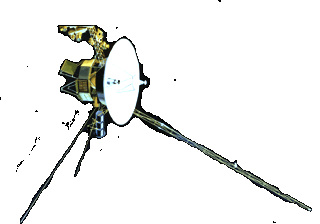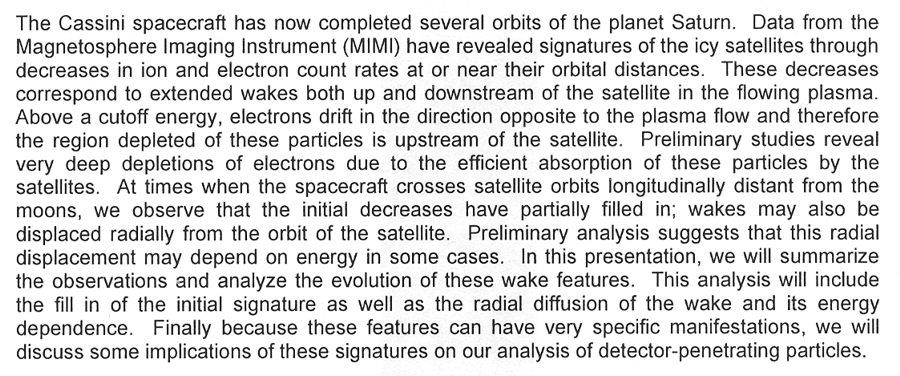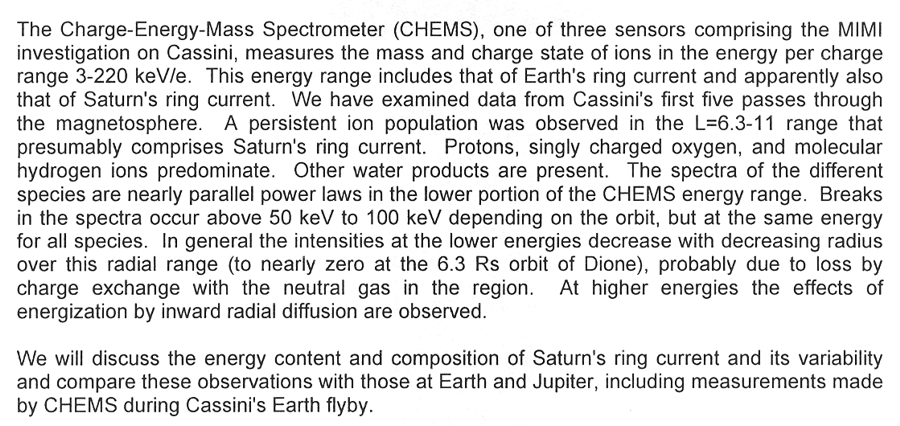Thomas P. Armstrong - Non-AGU Meeting Abstracts
T. P. Armstrong, S. Taherion, T. Sorensen, and H. Garrett, Absorption of Relativistic Electrons by Orbiting Jovian Dust, Magnetospheres of the Outer Planets (MOP) Conference, Leicester, 2005. Abstract:
|
|
N. Krupp, A. Lagg, J. Woch, E. Roussos, S. M. Krimigis, S. Livi, D. G. Mitchell, E. C. Roelof, C. Paranicas, J. Saur, D .C. Hamilton, T. P. Armstrong, and M. K. Dougherty, The Saturnian Magnetosphere as Revealed by Energetic Particle and Magnetometer Measurements: Cassini Results, Magnetospheres of the Outer Planets (MOP) Conference, Leicester, U.K., 2005. Abstract:
|
|
C. Paranicas, D. G. Mitchell, N. Krupp, S. M. Krimigis, J. Saur, F. Crary, H. McAndrews, D. Williams, B. H. Mauk, S. Livi, T. P. Armstrong, and S. Turner, Icy Satellite Microsignatures Observed by Cassini/MIMI During its First Orbits of Saturn, Magnetospheres of the Outer Planets (MOP) Conference, Leicester, U.K., 2005. Abstract:
|
|
D. C. Hamilton, M .E. Hill, S. M. Krimigis, D. G. Mitchell, B. H. Mauk, J. Dandouras, S. Livi, N. Krupp, and T. P. Armstrong, Observations of Saturn's Ring Current and Comparisons with Earth and Jupiter, Magnetospheres of the Outer Planets (MOP) Conference, Leicester, U.K., 2005. Abstract:
|
|
F. Vitt, C. Jackman, T. P. Armstrong, and T. E. Cravens, A Comparison of Sources of Odd Nitrogen Production from 1974 through 1993 in the Earth's Atmosphere as Calculated Using a Two-Dimensional Model, 1995 IUGG Meeting, Boulder, CO, July 1995. Abstract:
| Analysis of nitrates measured in polar ice cap snow at a high resolution shows large variations in the nitrates. Periods of large particle precipitation events can lead to a production of polar atmospheric odd nitrogen in excess of the ambient sources in the polar regions which may leave a large nitrate signal stratified in the polar ice cap. The odd nitrogen source strengths associated with solar proton events (SPEs), galactic cosmic rays (GCRs), and the oxidation of nitrous oxide in the Earth's middle atmosphere from 1974 through 1993 have been compared globally, at middle and lower latitudes (<500), and polar regions (>500) with a two-dimensional (2-D) photochemical transport model. As discovered previously, the oxidation of nitrous oxide dominates the global odd nitrogen source while GCRs and SPEs are significant at polar latitudes. The horizontal transport of odd nitrogen, produced by the oxidation of nitrous oxide at latitudes <500, was found to be the dominant source of odd nitrogen in the polar regions with GCRs contributing substantially during the entire solar cycle. The source of odd nitrogen from SPEs was more sporadic; however, contributions during several years (mostly near solar maximum) were significant in the polar middle atmosphere. |
Return to Fundamental Technologies Home Page.
Updated 03/11/2019
Cameron Crane
RELATED LINKS
(relatedContent)




